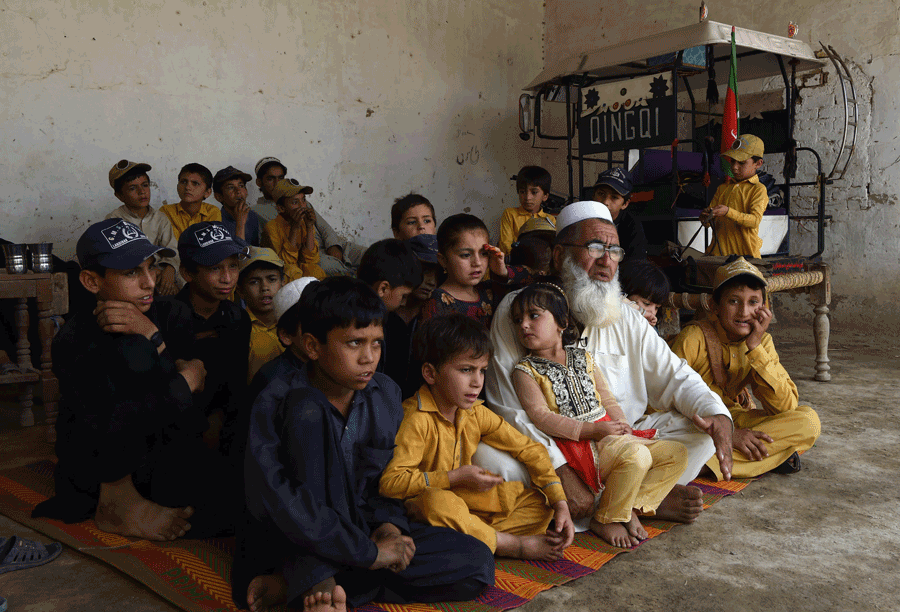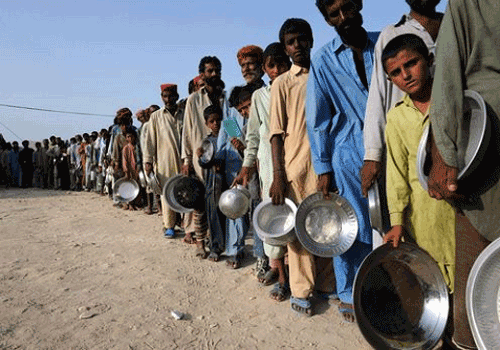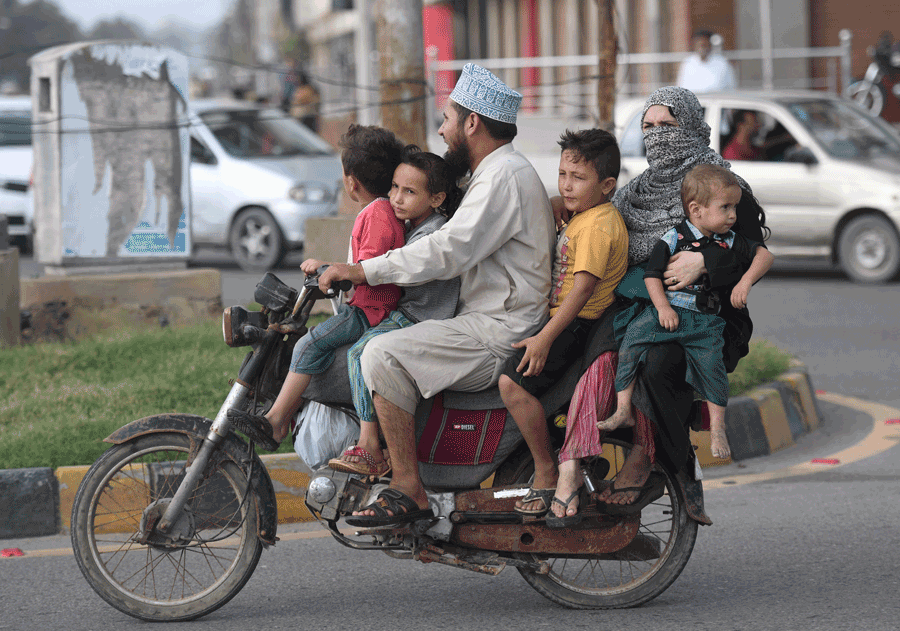Running Out of Space
By Afsheen Ahmed | People | Published 6 years ago
I first came across the ‘population’ issue when working at Herald in the early 1980s. The editor informed me that I would be joining a group of journalists travelling to the interior of Sindh with Dr Attiya Inayatullah, who was then an adviser on Population Welfare to President Zia-ul-Haq and later became a member of his Majlis-e-Shura. She was also the President of the Family Planning Association of Pakistan (FPAP), the premier organisation working in the field of family planning, as it was then known (since then, the terminology has evolved to a more holistic approach – and is now included as a component of reproductive health). Anyway, so the caravan set off from Karachi to Thatta, with a full police escort.
Inayatullah, with her forceful personality, made an impression. I had little to no idea of what family planning work involved, so this was a learning curve – not just for me alone.
Surprisingly, even senior journalists who were in this group seemed to know little – and cared even less. Despite the statistics, all the dire predictions by Dr Inayatullah, of the dangers of uncontrolled population growth on the development of the country and society, there was little interest shown by the journalists in that group. Their concern was perfunctory at best. That surprised me then. No more.
I learned a great deal on that trip and it fuelled my interest to later work in this sector. But that’s a different story. A new condom was being launched, and that was the apparent reason for the trip – to announce its arrival and make it available at FPAP clinics. I found the conversation around the subject risqué, which I now realise, I was right to be critical of. So many decades later, I find it is our attitude towards issues that determines the outcome.

Out of control: Gulzar Khan of Bannu, has 37 children from three wives.
In the case of Pakistan, the story of population control and family planning has been a sorry tale of good intentions, but thoughtless execution. Pakistan was one of the first Asian countries to begin a family planning programme, with some help from international donors. President Ayub Khan was the first leader brave enough to broach the issue at the government level in the late 1950s, and it was during his time that family planning was first launched at the government level.
The slogan was, “Hum do, humarey do.” The intervention was timely. Unfortunately, no proper study was conducted on how to get the message across in a manner that would not cause any offence. The religious clergy were not included, nor were behavioural psychologists on board. As with so much in life, it’s not what is said, but how. The message was ignored. And not just by the people. Had there been some thought and strategising and actual involvement of the bureaucrats and the government machinery, Pakistan’s population profile might have been very different now.
Then, the country broke apart in 1971 and the new civil martial law-cum-democratic dispensation of Zulfikar Ali Bhutto had no time to obsess over the issue. This was followed by the long martial law reign of Zia-ul-Haq during which the population issue was revived without fanfare. Advertising for family planning was banned and there were funding cuts, and yet enormous work was being done in the family planning field by the non-governmental sector, especially when Dr Mahbubul Haq (who established the famous UNDP Human Development Report that later led to the Human Development Index) was the Minister of Finance and Planning, under Zia-ul-Haq (1982-1988).
Haq initiated the first coordinated approach to the family planning sector by setting up the Non-Governmental Coordinating Council (NGOCC), with its headquarters in Karachi. In under a year, the NGOCC had nearly 600 NGOs on its register and the training and outreach programme took off with great success. The message and services for FP were being taken to the grassroots in a coordinated, efficient manner.
Of course, all good things invite jealousy. And so did the NGOCC. Under the second Pakistan People’s Party (PPP) government of Benazir Bhutto, the headquarters were shifted to Islamabad in 1994 (and renamed the National Trust for Population Welfare), and henceforth only the staff had job security thanks to the trust fund of the NGOCC, but no one bothered to check if they actually did anything, or supported any worthwhile initiative in the NGO sector.
That, in a nutshell, is the story of why the population issue has never been seriously addressed in Pakistan. Because governments, particularly democratic ones, simply cannot be bothered. Perhaps they are afraid to tackle issues deemed to be sensitive and don’t consider it necessary to worry about the future. Que sera, sera.
 The final nail in the population coffin was struck courtesy the 18th Amendment, when what was once a federal issue (and probably should have remained one, despite problems of centralisation) was devolved to the provinces. Perhaps I am being cynical, but with the NFC Award based primarily on population share, provinces are not particularly concerned about reaching population control targets.
The final nail in the population coffin was struck courtesy the 18th Amendment, when what was once a federal issue (and probably should have remained one, despite problems of centralisation) was devolved to the provinces. Perhaps I am being cynical, but with the NFC Award based primarily on population share, provinces are not particularly concerned about reaching population control targets.
Pakistan’s first census, in 1951, showed that the country had a population of 75 million – out of which 33.7 million resided in West Pakistan and 42 million in East Pakistan. In other words, the population of the western wing was lower than that of the eastern wing by almost 8 million. Yet by 2020, it is estimated that Pakistan will have a population of approximately 220 million, while Bangladesh’s population is expected to reach 170 million.
Why this enormous disparity of nearly 50 million? According to Professor John Cleland of the Centre for Population Studies at the London School of Hygiene and Tropical Medicine, the major reason for this is that “Bangladesh benefited from innovative (and sustained) government policies.” From the mid-1970s, Bangladesh adopted a community-based approach, recruiting married and literate, village women, trained in basic medicine and family planning, to go door-to-door dispensing contraceptive pills and condoms and referring women for clinical contraception.
“They acted as a bridge between the modern medical world and the village world,” says Cleland. “Because they were literate, they were part of the elite, and as villagers, they had credibility among a suspicious and very religious population. Simultaneously, the government prioritised girls’ education.” Continuing education delays marriage and childbearing, and equips girls with the ability to have greater control over their lives.
This two-pronged and sustained approach, despite political upheavals and change of leadership over several decades, is the secret of Bangladesh’s success story in getting a grip on the runaway population increase. Fertility rates in Bangladesh subsequently halved from about six children per woman in the early 1970s, to fewer than three children per woman today.
In contrast to Bangladesh’s broad-based strategy, Pakistan in the 1960s prioritised just one form of contraception – the intrauterine device (IUD). It paid doctors and midwives to promote the device and paid women to have it inserted. “All that money meant vast corruption and falsified figures, while there was not enough medical backup, so when women had problems with the IUDs they had nowhere to go,” says Cleland. “When someone did an honest survey, they found that no-one was using IUDs.”
Incidentally, in 1992, Pakistan’s Ministry of Population Welfare finally decided to take a different path and adopted the Bangladesh community-based (CBD) approach, as did a leading NGO consortium from Karachi. A cadre of female workers, taken from the communities themselves, were given training and support to go door-to-door explaining the family-planning concept, equipped with contraceptive supplies like pills and condoms, and referrals to the nearest health facility for clinical interventions.
The CBD approach proved successful – at least in the NGO sector. Later in the decade, the Ministry of Health also adopted the same approach, calling it the Lady Health Worker (LHW) scheme, with a broader health canvas to cover family planning as one of its components. Despite many setbacks, the LHW scheme is still running in some form.
Zeba Sathar, of the Population Council, contends that although Pakistan’s fertility rates exceed those of its South Asian neighbours, they have actually been in decline since the late 1980s.
According to her, this shift cannot be attributed to contraception, since the contraceptive prevalence rates still hover around 35 per cent, but is primarily “a consequence of the rising age at marriage [for women, this increased from 16 to 23 between 1961 and 2007] and the widespread recourse to abortions.”
Estimates suggest that one out of every seven pregnancies in Pakistan is aborted. Sathar writes that “The evidence is compelling that Pakistani women aged 35 and over, and with more than three children, are using abortions to regulate fertility.” This is the elephant in the room that is conveniently ignored.
However, even though Pakistani fertility rates are falling, the pace of this decline slowed over the first decade of the 21st century. Sathar, and all those associated with this sector, can rightly point the finger at international aid agencies for this decline. Since Pakistan is heavily dependent on international aid for its social sector, the agenda is set by the donors. And their priorities have shifted somewhat. The ‘politically correct’ sector they have focused on since early in this millennium, has been funding for HIV and AIDS, and downgrading funding for family planning/reproductive health.
While this has inevitably hampered family planning service provision, Sathar says this in no way excuses Pakistan’s failure in lowering fertility. As someone who has worked in this sector for over three decades, I wholeheartedly concur with her assessment that, “At no point has serious attention been devoted to studying Pakistan’s large population numbers, their distribution, and the implications they hold for the country’s development, politics, and ultimate stability. Politicians, the media and academia have not seriously debated Pakistan’s population issues, while economists and planners have all but ignored them.”
Successive governments, she adds, have also failed to improve the status of women. Female literacy stands at 44 per cent (in some places, the figure is as low as 35 per cent), while women’s participation in labour is barely 20 per cent. Both are major factors in determining fertility and women’s own choice in the matter.

Many other reasons are given as an excuse – a lack of access to contraceptives, men’s opposition to the use of contraception, their families’ expectations and religious opposition to the use of contraceptives. Though Pakistani couples commonly cite religious reasons for avoiding birth control, there is not one definitive agreement about family planning and contraception in Islam. In fact, many local religious figures are supportive of family planning and have begun discussions in their communities in order to promote the health of women and children. Moreover, the Pakistan Demographic and Health Survey of 2006-7 showed that religious reasons accounted for only nine per cent of FP non-use.
And if religion was a factor, how come countries like Iran and Bangladesh have managed to break the mould? For example, where in the world must couples attend contraception classes before getting married? Where has free distribution of contraceptives, increased access to sterilisation and edicts from religious leaders affirming women’s rights, contributed to one of the most dramatic drops in birth rates ever recorded?
“The answer is Iran,” says a report. Following the 1986 census, family planning was considered a priority by religious and political leaders; “Between 1988 and 1996, the average family halved in size, from 5.2 to 2.6 children, after the authorities launched a family planning campaign. It encouraged women to wait three to four years between pregnancies and discouraged childbearing for women younger than 18, or those older than 35. Fatwas confirmed a woman’s right to control her fertility.”
The use of contraceptives by married couples in Iran skyrocketed to nearly 80 per cent by 2006. This shows that it can be done, if backed by political will and sustained support from the government at all levels. In Pakistan, each time the government has changed, so have social sector priorities. And we are reaping the result.
Obviously, something is not working and it’s time to change. Harping on about the same issues – related to population and reproductive health – at seminars and events across the country, needs to be put on hold. The same people, the same topics, the same trite solutions that are rarely implemented beyond solemn recommendations in rarefied surroundings, is a depressing testament to our apathy and our absolute disconnect with reality. Our thoughtlessness is costing the country now and destroying hope for future generations.
The donors too cannot be absolved of blame. For one thing, the concentration in Islamabad of most international donor agencies is not a good thing; they are in a comfort zone and many do not want to move further than KP or Punjab, when it comes to granting projects and grants. It is so much easier to travel there by road for monitoring and support and return to Islamabad quickly.
Sindh and Balochistan have suffered from this benign neglect. The other problem is duplication.
How many times have midwives’ training manuals, for example, been developed by different donor agencies? Or other IEC and training materials – whether for family planning, gender violence, or HIV and AIDS protocols and so on and so forth? Attempting to recall how many I have personally been involved with, made my head spin. In how many ways can you say the same thing?
How much human resource and money were spent in developing and printing them? And then so much of this precious resource is lying around in boxes, because there is no centralised ‘library’ to encourage sharing.
Hopefully, things have changed now, since you can email most material and it can be printed as needed. Donors are also responsible for wasted funds. In one particularly large-scale mother-and-child health intervention in Sindh, about a decade ago, there was a substantial amount blocked for ‘advocacy’ events, in which food was supposed to be served and the issue of mothers needing services discussed.
Primarily, the donor supported the upgradation of birthing facilities at the local level – which is a positive development – and then decided to organise these community advocacy events via local partner NGOs, to spread the message. But this proved to be an exercise in futility. Absurd demands were made by the community for the lunch menu – special palla fish, soft drinks in cans from the nearest big urban facility, etc.
Local bigwigs were invited; the donor head in Islamabad and others would drop in to grace the event with their presence and after the obligatory speeches and generous repast, everyone left feeling good. Did the expecting mothers benefit? They probably did at the time. But the last I heard, the government did not continue to maintain these centres after the close of the project, despite having promised to do so. Incidentally, a must-read book for all those involved or interested in this sector in Pakistan, is Samia Waheed Altaf’s So Much Aid, So Little Development: Stories from Pakistan. You will first laugh out loud and then be overcome by sadness.
So does this mean we are doomed to failure at coming to grips with our population issue? No, not at all, as can be seen from the two success stories of countries similar to us. But we need to understand that this cannot be done in an ad hoc fashion, in an on-again, off-again manner. There has to be consensus, an agreement among all stakeholders – civil society, politicians, the media, medical practitioneers and the armed forces – that regardless of who is in power, once a plan has been drawn-up at provincial and at federal levels, it will not be tampered with for its duration.
Without this kind of consensus, we will fail yet again. Pakistan failed to meet its Millenium Development Goals and it is probably going to forfeit meeting the 2030 Agenda for Sustainable Development Goals (17) adopted by UN member states, in 2015.
Funds and other resources will be available once we show we mean business. As the Iranian and Bangladeshi examples have shown, successful strategies include, first and foremost, a consensus on the need for family planning and the creation of a supportive environment. This is to be followed by the reorientation and expansion of family planning services, the training of skilled personnel, the provision of free contraceptives and vasectomy and tubectomy services, the involvement of volunteers and non-governmental organisations and the promotion of male participation.
None of this is rocket science. Pakistan already has most of the technical know-how, so why the dismal outcome? The answer is that there is need for an increased awareness about the issue, which can then lead to more people caring about the problem and developing the will to bring about change.


